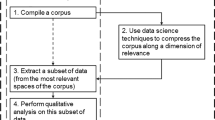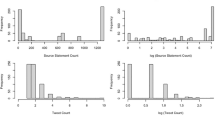Abstract
In modern politics, parties and individual candidates must have an online presence and usually have dedicated social media coordinators. In this context, we study the usefulness of analysing Twitter messages to identify both the characteristics of political parties and the political leaning of users. As a case study, we collected the main stream of Twitter related to the 2010 UK General Election during the associated period—gathering around 1,150,000 messages from about 220,000 users. We examined the characteristics of the three main parties in the election and highlighted the main differences between parties. First, the retweet structure is highly clustered according to political parties. Second, users are more likely to refer to their preferred party and use more positive affect words for the party compared with other parties. Finally, the self-description of users and the List feature can reflect the political orientation of users. From these observations, we develop both an incremental and practical classification method which uses the number of Twitter messages referring to a particular political party or retweets, and a classifier leveraging the valuable semantic content of the List feature to estimate the overall political leaning of users. The experimental results showed that the proposed incremental method achieved an accuracy of 86 % for classifying the users’ political leanings and outperforms other classification methods that require expensive costs for tuning classifier parameters and/or knowledge about network topology. This advantage allows this approach to be a good candidate for social media analytics application in real time for political institution. The proposed method using List feature, in turn, achieved an accuracy of 92 %.











Similar content being viewed by others
Notes
An online version of LIWC is available at http://www.liwc.net.
References
Adamic L, Glance N (2005) The political blogosphere and the 2004 U.S. election: divided they blog. In: International workshop on link discovery. Chicago, Illinois, pp 36–43
Aday S, Farrell H, Lynch M, Sides J, Kelly J, Zuckerman E (2010) Blogs and bullets: new media in contentious politics. Tech Rep. Issue no 65
Agarwal N, Liu H, Tang L, Yu PS (2012) Modeling blogger influence in a community. Soc Netw Anal Min 2(2):139–162
An J, Cha M, Gummadi K, Crowcroft J (2011) Media landscape in Twitter: a world of new conventions and political diversity. In: International conference on weblogs and social media. AAAI, Barcelona, Spain
Asur S, Huberman BA (2010) Predicting the future with social media. In: International conference on web intelligence and intelligent agent technology. vol 1, Washington, DC, USA, pp 492–499
Balasubramanyan R, Cohen WW, Pierce D, Redlawsk DP (2012) Modeling polarizing topics: when do different political communities respond differently to the same news? In: International conference on weblogs and social media. IAAA, Dublin, Ireland
Bastian M, Heymann S, Jacomy M (2009) Gephi: an open source software for exploring and manipulating networks. In: International conference on weblogs and social media. IAAA, San Jose, California, USA
Baumgartner JC, Morris JS (2010) MyFaceTube politics: social networking web sites and political engagement of young adults. Soc Sci Comput Rev 28(1):24–44
Benevenuto F, Rodrigues T, Cha M, Almeida V (2009) Characterizing user behavior in online social networks. In: Conference on internet measurement conference. Chicago, Illinois, USA
Boutet A, Kim H, Yoneki E (2012a) What’s in your tweets? i know who you supported in the UK 2010 general election. In: International conference on weblogs and social media. IAAA, Dublin, Irlande
Boutet A, Yoneki E, Hyoungshick K (2012b) What’s in twitter: i know what parties are popular and who you are supporting now! In: International conference on advances in social networks. Istanbul, Turkey
Branting K (2012) Context-sensitive detection of local community structure. Soc Netw Anal Min 2(3):279–289
Cha M, Haddadi H, Benevenuto F, Gummadi P (2010) Measuring user influence in Twitter: the million follower fallacy. In: International conference on weblogs and social media. IAAA, Washington, DC, USA
Conover M, Ratkiewicz J, Francisco M, Gonçalves B, Flammini A, Menczer F (2011) Political polarization on twitter. In: International conference on weblogs and social media. IAAA, Barcelona, Spain
Diakopoulos NA, Shamma DA (2010) Characterizing debate performance via aggregated twitter sentiment. In: Conference on human factors in computing systems. Atlanta, Georgia, USA, pp 1195–1198
Downey E, Jones MA (2012) Public service, governance and web 2.0 technologies: future trends in social media. IGI Publishing
Druckman JN, Peterson E, Slothuus R (2013) How elite partisan polarization affects public opinion formation. Am Political Sci Rev 107:57–79
Gayo-Avello D, Metaxas PT, Mustafaraj E (2011) Limits of electoral predictions using twitter. In: International conference on weblogs and social media. IAAA, Barcelona, Spain
Golbeck J, Hansen D (2011) Computing political preference among twitter followers. In: conference on human factors in computing systems. Vancouver, BC, Canada, pp 1105–1108
Hewstone M, Brown R (1986) Contact is not enough: an intergroup perspective on the “Contact Hypothesis”. In: Contact and Conflict in Intergroup Relations. Blackwell, UK
Kaschesky M, Sobkowicz P, Bouchard G (2011) Opinion mining in social media: modeling, simulating, and visualizing political opinion formation in the web. In: International Conference on Digital Government Research. College Park, MD, USA
Kashoob S, Caverlee J (2012) Temporal dynamics of communities in social bookmarking systems. Soc Netw Anal Min 2(4):387–404
Kramer AD (2010) An unobtrusive behavioral model of “gross national happiness”. In: Conference on human factors in computing systems. Atlanta, Georgia, USA, pp 287–290
Lin F, Cohen WW (2008) The multirank bootstrap algorithm: Self-supervised political blog classification and ranking using semi-supervised link classification. In: International conference on weblogs and social media. IAAA, Seattle, WA, USA
Livne A, Simmons MP, Adar E, Adamic LA (2011) The party is over here: structure and content in the 2010 election. In: International conference on weblogs and social media. IAAA, Barcelona, Spain
Loukis E, Charalabidis Y (2012) Participative public policy making through multiple social media platforms utilization. Int J Electron Gov Res 8(3):78–97
Mcclurg SD (2003) Social networks and political participation: the role of social interaction in explaining political participation. Political Res Q 56:449–464
O’Connor B, Balasubramanyan R, Routledge BR, Smith NA (2010) From tweets to polls: linking text sentiment to public opinion time series. In: International conference on weblogs and social media. IAAA, Washington, DC, USA
Pennacchiotti M, Popescu AM (2011a) Democrats, republicans and starbucks afficionados: User classification in twitter. In: International conference on knowledge discovery and data mining. San Diego, California, USA, pp 430–438
Pennacchiotti M, Popescu AM (2011b) A machine learning approach to twitter user classification. In: International conference on weblogs and social media. IAAA, Barcelona, Spain
Petersen MB, Slothuus R, Togeby L (2010) Political parties and value consistency in public opinion formation. Public Opin Q 74(3):530–550
Quercia D, Ellis J, Capra L, Crowcroft J (2011) In the mood for being influential on Twitter. In: International conference on social computing. Boston, MA, USA, pp 307–314
Quercia D, Ellis J, Capra L, Crowcroft J (2012) Tracking gross community happiness from tweets. In: Conference on computer supported cooperative work. Seattle, Washington, USA, pp 965–968
Quercia D, Lambiottez R, Stillwell D, Kosinski M, Crowcroft J (2012) The personality of popular facebook users. In: Conference on computer supported cooperative work. Seattle, Washington, USA, pp 955–964
Raghavan UN, Albert R, Kumara S (2007) Near linear time algorithm to detect community structures in large-scale networks. Phys Rev E 76(3):036106
Sarita Y, Danah B (2010) Dynamic debates: an analysis of group polarization over time on twitter. Bull Sci Technol Soc 30(5):316–327
Sharma NK, Ghosh S, Benevenuto F, Ganguly N, Gummadi K (2012) Inferring who-is-who in the twitter social network. In: Workshop on online social networks. Helsinki, Finland, pp 55–60
Sobkowicz P, Kaschesky M, Bouchard G (2011) Opinion formation in the social web: agent-based simulations of opinion convergence and divergence. In: Agents and data mining interaction. vol 7103. Taipei, Taiwan, pp 288–303
Stieglitz S, Dang-Xuan L (2012) Political communication and influence through microblogging–an empirical analysis of sentiment in twitter messages and retweet behavior. In: Hawaii international conference on system sciences. IEEE Computer Society, Grand Wailea, Maui, Hawaii, pp 3500–3509
Stieglitz S, Dang-Xuan L (2012) Social media and political communication: a social media analytics framework. Social Network Analysis and Mining
Traunmüller R (2010) Web 2.0 creates a new government. In: Electronic Government and the Information Systems Perspective. Bilbao, Spain, pp 77–83
Tumasjan A, Sprenger TO, Sandner PG, Welpe IM (2010) Election forecasts with twitter: How 140 characters reflect the political landscape. Soc Sci Comput Rev 29(4):402–418
Vasudevan M, Deo N (2012) Efficient community identification in complex networks. Soc Netw Anal Min 2(4):345–359
Wattal S, Schuff D, Mandviwalla M, Williams CB (2010) Web 2.0 and politics: the 2008 U.S. presidential election and an e-politics research agenda. MIS Q 34(4):669–688
Zhang W, Johnson TJ, Seltzer T, Bichard SL (2009) The Revolution Will be Networked: The Influence of Social Networking Sites on Political Attitudes and Behavior. Soc Sci Comput Rev 28(1):75–92
Zhou DX, Resnick P, Mei Q (2011) Classifying the political leaning of news articles and users from user votes. In: International conference on weblogs and social media. July, IAAA, Barcelona, Spain
Acknowledgments
This research is part-funded by the EU grants for the RECOGNITION project (FP7-ICT 257756), the EPSRC DDEPI Project, EP/H003959 and by the ERC Starting Grant GOSSPLE number 204742.
Author information
Authors and Affiliations
Corresponding author
Rights and permissions
About this article
Cite this article
Boutet, A., Kim, H. & Yoneki, E. What’s in Twitter, I know what parties are popular and who you are supporting now!. Soc. Netw. Anal. Min. 3, 1379–1391 (2013). https://doi.org/10.1007/s13278-013-0120-1
Received:
Revised:
Accepted:
Published:
Issue Date:
DOI: https://doi.org/10.1007/s13278-013-0120-1




